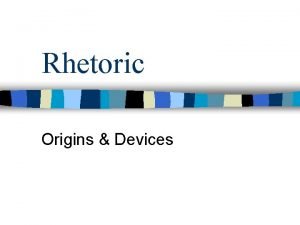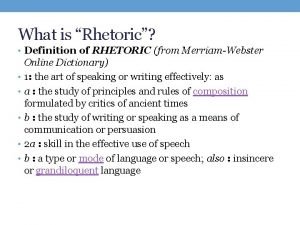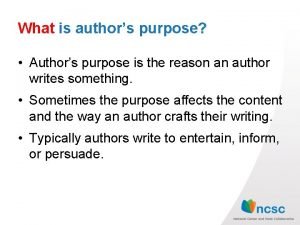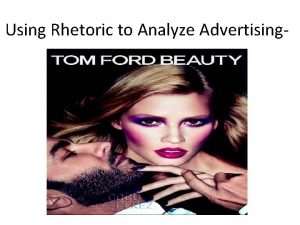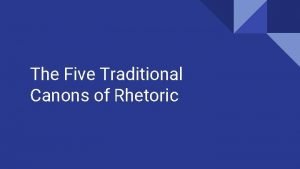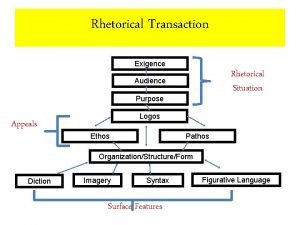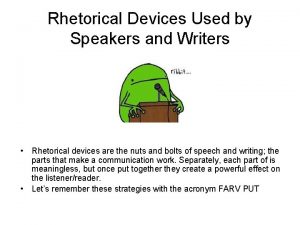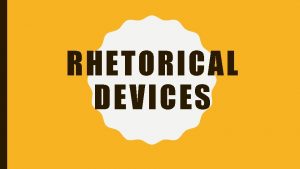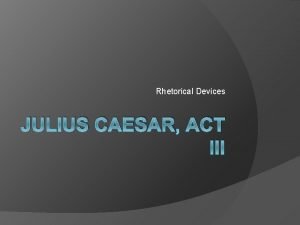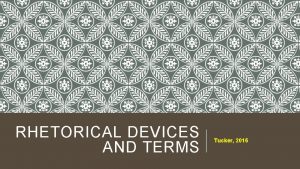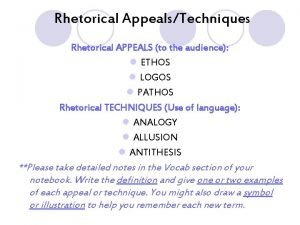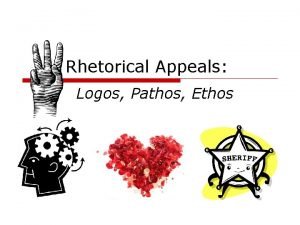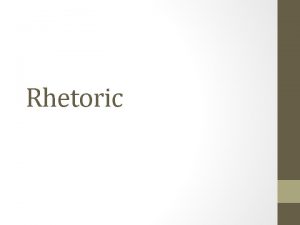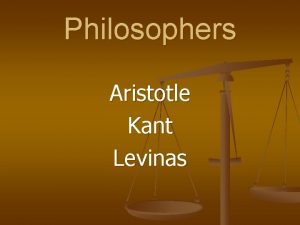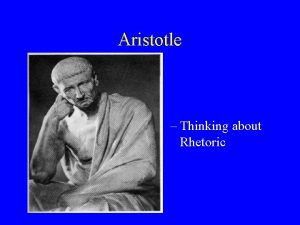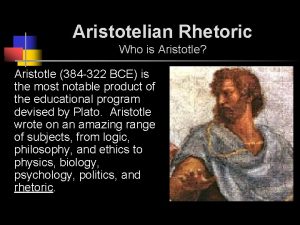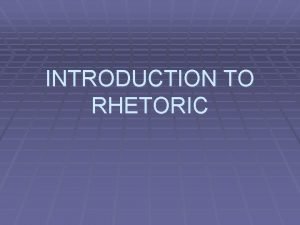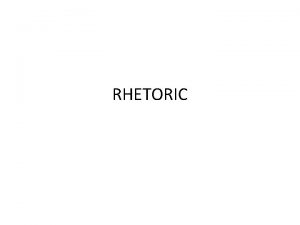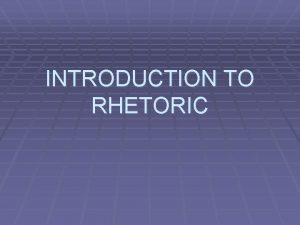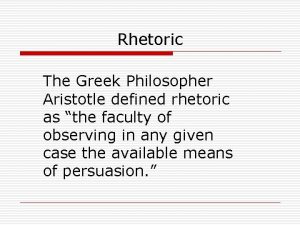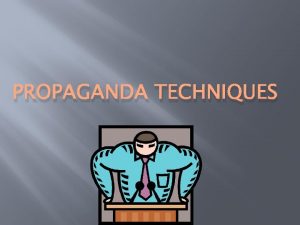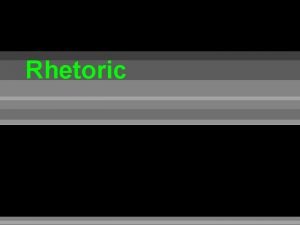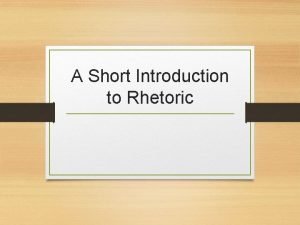Methods for Rhetorical Analysis Aristotle Rhetoric is the

















- Slides: 17

Methods for Rhetorical Analysis Aristotle: Rhetoric is "the faculty of discovering in any particular case all of the available means of persuasion. "

Rhetorical Analysis: Critical Reading When you are asked to do a "rhetorical analysis" of a text, you are being asked to apply your critical reading skills to break down the "whole" of the text into the sum of its "parts. " You try to determine what the writer is trying to achieve, and what writing strategies he/she is using to try to achieve it.

Questions to ask for a Critical Reading: • What is the general subject? Does the subject mean anything to you? Does it bring up any personal associations? Is the subject a controversial one? • What is thesis (the overall main point)? How does thesis interpret/comment on the subject? • What is the tone of the text? Do you react at an emotional level to the text? Does this reaction change at all throughout the text? • What is the writers' purpose? To explain? To inform? To anger? Persuade? Amuse? Motivate? Sadden? Ridicule? Anger? Is there more than one purpose? Does the purpose shift at all throughout the text? • How does the writer develop his/her ideas? Narration? Description? Definition? Comparison? Analogy? Cause and Effect? Example? Why does the writer use these methods of development?

Questions to ask for a Critical Reading: How does the writer arrange his/her ideas? What are the patterns of arrangement? Particular to general? Broad to specific? Spatial? Chronological? Alternating? Block? Is the text unified and coherent? Are there adequate transitions? How do the transitions work? What is the sentence structure like in the text? Does the writer use fragments or run-ons? Declarative? Imperative? Interrogative? Exclamatory? Are they simple? Compound? Complex? Compoundcomplex? Short? Long? Loose? Periodic? Balanced? Parallel? Are there any patterns in the sentence structure? Can you make any connections between the patterns and the writers' purpose? Does the writer use dialogue? Quotations? To what effect? How does the writer use diction? Is it formal? Informal? Technical? Jargon? Slang? Is the language connotative? Denotative? Is the language emotionally evocative? Does the language change throughout the piece? How does the language contribute to the writers' aim?

Questions to ask for a Critical Reading: • Is there anything unusual in the writers' use of punctuation? What punctuation or other techniques of emphasis (italics, capitals, underlining, ellipses, parentheses) does the writer use? Is punctuation over- or under used? Which marks does the writer use when, and for what effects? Dashes to create a hasty breathlessness? Semi-colons for balance or contrast? • Are important terms repeated throughout the text? Why? • Are there any particularly vivid images that stand out? What effect do these images have on the writers' purpose? • Are devices of comparison used to convey or enhance meaning? Which tropes--similes, metaphors, personification, hyperbole, etc. does the writer use? When does he/she use them? Why? • Does the writer use devices of humor? Puns? Irony? Sarcasm? Understatement? Parody? Is the effect comic relief? Pleasure? Hysteria? Ridicule?

Rhetorical Devices: Sound-based rhetorical devices add a poetic melody to speeches making speeches more pleasurable to listen to. Three of the most common forms are: alliteration — repetition of the same sound at the beginning of nearby words e. g. “what my wife wanted”, “her husband has had” assonance — repetition of the same vowel sound in nearby words e. g. “how now brown cow” onomatopoeia — a word which imitates the sound of itself e. g. “buzz”, “whoosh”, “meow”

Rhetorical Devices: Repetition of Words or Ideas Two common forms involve repetition in successive clauses or sentences. anaphora — repetition of a word or phrase at the start of successive clauses or sentences e. g. Winston Churchill “We shall not flag or fail. We shall go on to the end. We shall fight in France, we shall fight on the seas and oceans, [. . . many more. . . ] We shall never surrender. ” epistrophe — repetition of a word or phrase a the end of successive clauses or sentences e. g. Emerson “What lies behind us and what lies before us are tiny compared to what lies within us. ”

• Repetition is a powerful technique used in other ways as well. • Repetition is commonly used for emphasis. • Repeating a word or phrase in different parts of the speech helps the audience make connections as if you were sewing your speech elements together with a thread.

Rhetorical Devices Which Change Word Meanings Three common rhetorical devices by which words can take on new meanings are: Personification — giving human qualities to abstract ideas, inanimate objects, plants, or animals e. g. “The trees called out to me. ” Metaphor — a comparison of two seemingly unlike things e. g. “Life is a highway. ” Simile — same as metaphor, but using either “like” or “as” e. g. “Life is like a box of chocolates. ” These rhetorical devices, along with related concepts such as symbolism and analogies, are often the essence of storytelling as an effective means of communication.

Parallelism Repetition of a word or grammatical structure for effect. The classic example comes from Martin Luther King’s “I Have a Dream” speech, with the repetition of the phrase “I have a dream. ” Usually the repetition will follow the same grammatical pattern (such as Subject-Verb-Object). Parallelism is used for emphasis, rhythm, and poetic effect.

Statistics Facts expressed in quantifiable form such as numbers, charts, or graphs that can lend support to a claim or warrant but that are not irrefutable proof. Although statistics can be manipulated to misrepresent the facts, they are usually quite convincing

Rhetorical Question A question not meant to be answered but to be pondered. A rhetorical question will be ineffective if it can be answered with a simple yes or no. Feminist abolitionist Sojourner Truth is known for her rhetorical question, “Ain’t I a woman? ”

Ethos, Pathos and Logos Ethos: Persuasive appeal based on the projected character of the speaker. According to Aristotle, the chief components of a compelling ethos are good will, practical wisdom, and virtue. Logos: In classical rhetoric, the means of persuasion by demonstration of the truth, real or apparent. Pathos: The means of persuasion in classical rhetoric that appeals to the audience's emotions.

Rhetorical Analysis: Critical Writing When you write a rhetorical analysis, all you're really doing is putting onto paper the strategies you discovered/ideas you came up with when reading the text critically. The guidelines on the next slide detail the aspects of the text you might consider discussing, and they offer you some direction in terms of organizing your paper. Remember that you do not have to cover all of these aspects when writing a formal rhetorical analysis.

Guidelines for Rhetorical Analysis Your Title: What sort of title would describe your paper? Your Introduction: DETAILING THE RHETORICAL SITUATION • How would you describe the rhetorical situation? What will you say about the writer, the subject, the context, the audience, and the principal aim/purpose of the text? Are there any aims subordinate to the principal aim? • How would you summarize the essay in one or two sentences? (This should not be a lengthy paraphrase of the piece. ) What is the writer's thesis? • What features of substance and style will you focus on in the body of your essay, and why do you consider them so important to the discourse? (This is your thesis. )

Your Essay's Body: DISCUSSING THE STYLE OF THE TEXT • Which of the following features of style do you consider most important to the discourse and why? – language (including level of diction and tone of voice) – figurative language, symbolism, allusion (biblical, historical etc. ), irony – humour – number and length of paragraphs – length and style of sentences – rhythm and repetition • How do these particular features of style enable the writer to achieve her/his purpose?

Your Conclusion Use your conclusion to comment on the effect and effectiveness of the essay as a whole. How well does the writer achieve the purpose, appeal to the audience, and demonstrate the effect of style on content? • • Note the following conventions of analysis: Analyze a text in the simple present tense Enclose essay titles inside quotation marks Refer to yourself as "the reader" or "the audience" Support your claims with textual evidence (direct quotations and paraphrases)
 Aristotle rhetoric
Aristotle rhetoric Rhetorical device logos
Rhetorical device logos Wax pattern in fpd
Wax pattern in fpd You eat what you touch
You eat what you touch Rhetoric definition
Rhetoric definition Definition of authors purpose
Definition of authors purpose What is rhetoric
What is rhetoric 3 types of rhetoric
3 types of rhetoric Canons of rhetoric
Canons of rhetoric Logos ethos pathos
Logos ethos pathos Rhetorical stance
Rhetorical stance Exigence rhetoric
Exigence rhetoric Rhetorical devices
Rhetorical devices Rhetoricl devices
Rhetoricl devices Literary devices in julius caesar act 3
Literary devices in julius caesar act 3 Rhyming pattern
Rhyming pattern Ethos advertisement examples
Ethos advertisement examples Ethos rhetoric
Ethos rhetoric
